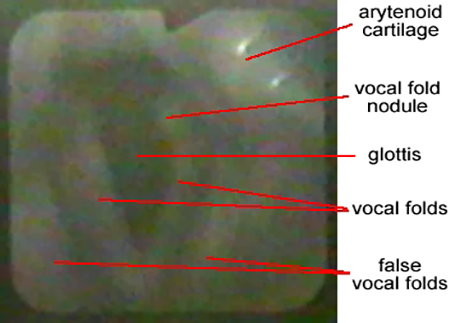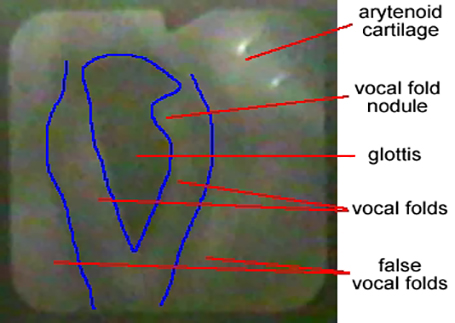Fibrescope
Fibrescopic examination of the larynx and velum
John Clark and Robert Mannell
The movies linked to on this page were originally filmed on a video tape by John Clark in 1979 at Reading University in England. The movies were transferred to digital format by the Centre for Flexible Learning at Macquarie University and were edited and digitally processed by Robert Mannell. The text accompanying these movies is based loosely on John Clark's narration on the original video tape with additional text and comments by Robert Mannell.
Introduction
All of the movies attached to this page are quite large. The majority are between 1 and 5 Mbytes. The exception is the introductory movie ("Fibrescopic Examination of the Larynx") which explains the technology and the technique of nasoendoscopy using a fibrescope. That movie is very large (nearly 50 Mbytes) and will take a while to download via a fast broadband connection.
| Video title | Video filename | File size |
| Fibrescopic examination of the larynx | fs01_intro.mov | 50,860 kB |
Structures of the pharynx and the larynx
Back of the tongue and the epiglottis
In this clip "...you can now see my larynx from above and the whitish looking object that keeps moving into the picture from the bottom is the back of the tongue and the epiglottis as I speak. And as I swallow you lose the picture all together. Its useful to swallow from time to time to keep the tip of the fibrescope clean and free mucous or from fogging."
In this clip you can briefly see the epiglottis separated slightly from the back of the tongue. In most of the other clips the epiglottis is either not visible or is a whitish structure not visibly separated from the back of the tongue.
Arytenoid cartilages
In this clip (and most other clips showing the vocal folds) you should be able to see the "...arytenoid cartilages at the top of the picture. ... You should be able to see them moving as I open and close the vocal folds." Note in particular the way that they rotate as the vocal folds open and close. This clip displays both a medium distance and a close-up shot of the arytenoids.


Vocal folds and false vocal folds
In this clip, "...you should all be able to see the true and false vocal folds. If you look at the larynx, with the vocal folds lightly closed …you should be able to see a pair of lips running vertically which are the true folds."
In this clip, "...if I then compress the vocal folds together you should be able to see the false vocal folds come over and cover the true folds." The contrast is particularly poor in this clip, but you can most clearly see the false vocal folds right at the end of the clip as they move away from their position covering the true vocal folds.
"If you look closely at the right hand vocal fold you'll see I have a small nodule. At least, I like to tell myself it’s small."
Vocal fold behaviour
Normal breathing and phonation
In this clip, "we shall look at the opening and closing of the folds during normal respiration. You can see that the folds were open slightly more when I was breathing in than when I was breathing out. And you can see them rapidly become adducted into the phonation ready position for the /i:/ vowel that I produced."
"I shall be using /i:/ vowels almost exclusively in this demonstration in order to keep to the body of the tongue out of the line of view from the position at which the fibrescope is placed."
Pitch control
In this clip, we will "look at ordinary pitch control by varying length and tension of the vocal folds using the cricothyroid muscle. The vocal folds gradually get longer as the pitch rises and become quite short for low pitch."
Normal modal phonation
This clip examines modal phonation during the production of an /i:/ vowel.
In the following three clips, breathy phonation, creaky phonation and whisper are all contrasted with normal phonation.
Breathy phonation
In this clip we examine "...breathy phonation in which the vocal folds are not quite as tightly closed as they are for normal phonation. There is a chink at the arytenoid end of the glottis through which air can escape, as well as escaping along the length of the membranous vocal folds."
Creaky phonation
In this clip we examine "...creaky voice in which the vocal folds are in fact quite slack and very short and thick."
Whisper
In this clip we examine whisper. "You should be able to see a small opening at the arytenoid end of the vocal folds which allows turbulent air to be forced through that narrow aperture and produce a sound source for whisper."
Glottal stops
In this clip, we will "...observe glottal articulation in which you will see the vocal folds in normal phonation and then compressed very strongly with a lot of medial compression causing the false folds to cover the true folds during the glottal stop. You can see the true folds disappear during the glottal stop."
Voiceless stops
"We shall look now at glottal and supraglottal activity and their co-ordination."
In this clip we will examine vocal fold behaviour during the production of voiceless stops. "During the voiceless stop the vocal folds are abducted and they do not come together again until the stop release."
Voiced stops
In this clip we will examine vocal fold behaviour during the production of voiced stops. In "voiced stops you won’t see vocal fold abduction, but you will see a slight lowering of the larynx to increase the pharyngeal volume to maintain the trans-glottal pressure necessary to keep the phonation going, during the occlusion phase of the voiceless stop. ... [During a voiced stop occlusion] there is a gradual rise in pressure in the cavity above the larynx and eventually a point is reached where it is not possible for phonation to be sustained because there is no significant difference in pressure above and below the larynx. One means of preserving some pressure difference during the occlusion is for the larynx to be lowered." During the slower articulations of these stops "...you'll notice that I held the occlusion so long that even with the lowering of the larynx there was still not enough differential pressure across the vocal folds to ensure continuance of phonation."
Voiceless fricatives
In this clip, we will "...look at voiceless fricatives. Again, you will see the vocal folds abduct during the frication phase."
Voiced fricatives
In this clip, we "look at voiced fricatives. In the compression of the vocal folds during the frication phase [there is] perhaps a little more air coming out [than occurs during normal phonation] to help sustain the frication on the voicing."
Consonant clusters
"Now let’s look at glottal activity during consonant clusters."
In this clip, we will look "...at a fricative plus stop cluster /i:sti:/ where again you will see the glottal aperture widely opened during the fricative and stop phase and then rapidly closed for the following vowel. ... There are one or two complex things happening here. First of all, there isn't as nearly as much aspiration on the /t/ as there would be if it was initially produced as a single, non-clustered consonant. Most of the airflow occurs during the fricative."
In this clip, we look at "a more complex cluster, /i:stri:/."
In this clip, we look at "another stop plus liquid consonant, /i:tri:/. ... You can see that the aperture of the vocal folds remain quite wide even well into the /r/ consonant which [is realised as] a voiceless fricative. This is regarded by some as being an affrication."
Velum behaviour
In this clip, we have "moved the fibrescope back slightly and take a look at the activity of the velum. The fibrescope is positioned in the posterior part of the nasal cavity and you can see, as I speak, the velum rising."
Oral and nasal stops
In this clip, we look at velum control during the production of oral and nasal stops. "If I make a voiceless stop, for example, as in /pa:/ you can see the back of the pharyngeal wall being closed off by the velum [to permit the build up of] ...inter-oral pressure. If I make a nasal stop you'll see the velum remains lowered. You may see it move slightly but that's all."
High versus low vowels
In this clip, we examine velum control during high (/i:, o:, u:/) and low vowels /a:/. "You'll see with the low vowel, there was virtually no sign of the velum at all. Whereas, for the high vowels there were appears to be almost complete closure, so that there is little or no possibility of air flow through the nasal tract during those high vowels. This is of course at least in part due to well known effect of mechanical coupling between the velum and the tongue via the palatoglossus muscle."
Vowel coarticulation between oral and nasal stops
In this clip, we examine "the effects of coarticulation which occur when we articulate the word 'pat', as opposed to 'man'. Now you will notice that in 'pat' the velum almost entirely obscures our view, whilst during 'man' it remains almost entirely lowered so that the vowel in 'man' has got a great deal more nasal air flow than the vowel in 'pat'."
Denasal, normal and nasalised vowels
In this clip, we examine velum control during the articulation of a denasal vowel, a normal vowel, and a nasalised vowel. In each case the vowel is /a:/. Compare these vowels with the vowels produced between oral and nasal stops (see above).
Conclusion
"That concludes the demonstration of the larynx and the velum viewed by means of the fibrescope. As you may see from this brief demonstration, it is a device which has great potential both for phonetic research into the mechanisms of laryngeal vibration and of laryngeal control during supraglottal articulation and into the movement of the velum [during speech, as well as] ... for more practical things such as the investigation of voice pathologies."
Content owner: Department of Linguistics Last updated: 12 Mar 2024 10:13am
